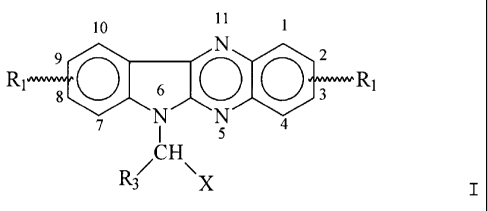Une partie des informations de ce site Web a été fournie par des sources externes. Le gouvernement du Canada n'assume aucune responsabilité concernant la précision, l'actualité ou la fiabilité des informations fournies par les sources externes. Les utilisateurs qui désirent employer cette information devraient consulter directement la source des informations. Le contenu fourni par les sources externes n'est pas assujetti aux exigences sur les langues officielles, la protection des renseignements personnels et l'accessibilité.
L'apparition de différences dans le texte et l'image des Revendications et de l'Abrégé dépend du moment auquel le document est publié. Les textes des Revendications et de l'Abrégé sont affichés :
| (12) Brevet: | (11) CA 2400236 |
|---|---|
| (54) Titre français: | DERIVES D'INDOLOQUINOXALINE ENTRANT DANS LA PREPARATION D'UN MEDICAMENT DE TRAITEMENT DE LA SCLEROSE EN PLAQUES |
| (54) Titre anglais: | USE OF INDOLOQUINOXALINE DERIVATIVES FOR PREPARING A DRUG FOR THE TREATMENT OF MULTIPLE SCLEROSIS |
| Statut: | Réputé périmé |
| (51) Classification internationale des brevets (CIB): |
|
|---|---|
| (72) Inventeurs : |
|
| (73) Titulaires : |
|
| (71) Demandeurs : |
|
| (74) Agent: | SMART & BIGGAR |
| (74) Co-agent: | |
| (45) Délivré: | 2009-09-22 |
| (86) Date de dépôt PCT: | 2001-02-16 |
| (87) Mise à la disponibilité du public: | 2001-08-23 |
| Requête d'examen: | 2005-11-25 |
| Licence disponible: | S.O. |
| (25) Langue des documents déposés: | Anglais |
| Traité de coopération en matière de brevets (PCT): | Oui |
|---|---|
| (86) Numéro de la demande PCT: | PCT/SE2001/000326 |
| (87) Numéro de publication internationale PCT: | WO2001/060371 |
| (85) Entrée nationale: | 2002-08-12 |
| (30) Données de priorité de la demande: | ||||||
|---|---|---|---|---|---|---|
|
L'invention concerne l'utilisation d'un composé de la formule (I) où R1 représente un hydrogène ou au moins un, de préférence 1 à 4, substituants similaires ou différents aux positions 1-4 et/ou 7-10, sélectionnés parmi halogène, de préférence brome, groupe alkyle/alcoxy inférieur ayant maximum 4 atomes de carbone, groupe trifluorométhyle, groupe trichlorométhyle; et, dans une des positions 7-10, peut représenter un groupe hydroxyle; X est un groupe -(CH2)n-R2, où R2 Représente un résidu basique contenant de l'azote tel que NH2, NHR4 ou NR5R6, où R4, R5 et R6 représentent indépendamment alkyle ou cycloalkyle inférieur et n est un nombre entier compris entre 1 et 4 et R3 Représente un hydrogène, un groupe alkyle/cycloalkyle inférieur ayant maximum 4 atomes de carbone, et des produits d'addition physiologiquement compatibles des composés avec des composés d'addition d'acide et d'halogène, de préférence des composés d'addition avec de l'iode, du monochlorure d'iode ou du monobromure d'iode, pour préparer un médicament permettant de traiter la sclérose en plaques.
Use of a compound of
formula (I) wherein R1 represents hydrogen
or one or several, preferably 1 to 4, similar
or different substituents in the positions 1-4
and/or 7-10, selected from halogen, preferably
Br, lower alkyl/alkoxy group having not more
than 4 carbon atoms, trifluoromethyl group,
trichloromethyl group; and in one of the
positions 7-10 R1 can be a hydroxyl group; X
is a group -(CH2)n-R2, wherein R2 represents
a nitrogen containing basic residue such as
NH2, NHR4 or NR5R6, wherein R4, R5 and R6
independently are lower alkyl or cycloalkyl and n is an integer of from 1 to 4
and R3 represents hydrogen, lower alkyl/cycloalkyl
group having not more than 4 carbon atoms, and the physiologically acceptable
addition products of the compounds with acids and
halogen adducts, preferably adducts with iodine, iodine monochloride or iodine
monobromide, for preparing a drug for treatment
of MS (multiple sclerosis).
Note : Les revendications sont présentées dans la langue officielle dans laquelle elles ont été soumises.
Note : Les descriptions sont présentées dans la langue officielle dans laquelle elles ont été soumises.

Pour une meilleure compréhension de l'état de la demande ou brevet qui figure sur cette page, la rubrique Mise en garde , et les descriptions de Brevet , États administratifs , Taxes périodiques et Historique des paiements devraient être consultées.
| Titre | Date |
|---|---|
| Date de délivrance prévu | 2009-09-22 |
| (86) Date de dépôt PCT | 2001-02-16 |
| (87) Date de publication PCT | 2001-08-23 |
| (85) Entrée nationale | 2002-08-12 |
| Requête d'examen | 2005-11-25 |
| (45) Délivré | 2009-09-22 |
| Réputé périmé | 2011-02-16 |
Il n'y a pas d'historique d'abandonnement
| Type de taxes | Anniversaire | Échéance | Montant payé | Date payée |
|---|---|---|---|---|
| Le dépôt d'une demande de brevet | 300,00 $ | 2002-08-12 | ||
| Enregistrement de documents | 100,00 $ | 2002-10-29 | ||
| Taxe de maintien en état - Demande - nouvelle loi | 2 | 2003-02-17 | 100,00 $ | 2003-01-23 |
| Taxe de maintien en état - Demande - nouvelle loi | 3 | 2004-02-16 | 100,00 $ | 2004-01-20 |
| Taxe de maintien en état - Demande - nouvelle loi | 4 | 2005-02-16 | 100,00 $ | 2005-01-28 |
| Requête d'examen | 800,00 $ | 2005-11-25 | ||
| Taxe de maintien en état - Demande - nouvelle loi | 5 | 2006-02-16 | 200,00 $ | 2006-01-04 |
| Taxe de maintien en état - Demande - nouvelle loi | 6 | 2007-02-16 | 200,00 $ | 2007-01-26 |
| Taxe de maintien en état - Demande - nouvelle loi | 7 | 2008-02-18 | 200,00 $ | 2008-02-07 |
| Taxe de maintien en état - Demande - nouvelle loi | 8 | 2009-02-16 | 200,00 $ | 2009-02-05 |
| Taxe finale | 300,00 $ | 2009-07-08 |
Les titulaires actuels et antérieures au dossier sont affichés en ordre alphabétique.
| Titulaires actuels au dossier |
|---|
| LUNDBLAD, LEIF J.I. |
| Titulaires antérieures au dossier |
|---|
| BERGMAN, JAN |
| MOLLER, LENNART |